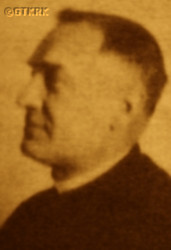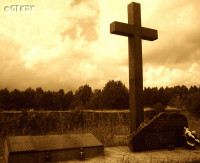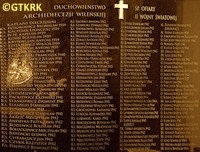Roman Catholic
St Sigismund parish
05-507 Słomczyn
85 Wiślana Str.
Konstancin deanery
Warsaw archdiocese, Poland
full list:
displayClick to display full list

searchClick to search full list by categories
wyświetlKliknij by wyświetlić pełną listę po polsku

szukajKliknij by przeszukać listę wg kategorii po polsku

Martyrology of the clergy — Poland
XX century (1914 – 1989)
personal data
surname
KUŹMICKI
forename(s)
Witold
function
diocesan priest
creed
Latin (Roman Catholic) Church RCmore on
en.wikipedia.org
[access: 2014.09.21]
diocese / province
Vilnius archdiocesemore on
en.wikipedia.org
[access: 2013.05.19]
Sejny diocesemore on
www.catholic-hierarchy.org
[access: 2021.12.19]
academic distinctions
Doctor of Philosophy
honorary titles
Gold „Cross of Merit”more on
Gold „Cross of Merit”
(14.08.1937)
Honorary Citizenmore on
Honorary Citizen
(14.08.1937, Dembrovotoday: Dembrovo ssov., Shchuchyn dist., Grodno reg., Belarus
more on
be.wikipedia.org
[access: 2023.01.18])
date and place
of death
15.07.1943

Navumavichytoday: Padlabiennie ssov., Grodno dist., Grodno reg., Belarus
more on
en.wikipedia.org
[access: 2022.01.06]
alt. dates and places
of death
13‑14.07.1943
details of death
During the Russian rule in part of partitioned Poland, when ministering in Brest–Litovsk (c. 1911), published, probably clandestinely, a magazine for young people named „Gwiazdka” (Eng. „Star”). Threatened by the occupying Russian authorities, secretly went to Rome again (was there earlier, in c. 1908, when successfully defended his doctorate in philosophy) to pursue studies in canon law. For financial reasons, interrupted his studies and returned to his diocese.
In 1913, appointed vicar and prefect of Vilnius, but the tsarist authorities did not approve it. During World War I, ministered in Dziembrów. Opposed the escape of Poles with Russians into Russia after the Russians' defeat in the battle against the Central Powers, i.e. Germany and Austria–Hungary, near Gorlice in 05.1915 (the so‐called „bezhenstvo”), for which was threatened with arrest. Managed to prevent it, and only one family from his parish left out of with c. 3 million Russians: officials of the occupational administration and their families, teachers, military personnel, Orthodox clergy, etc.
During the German occupation, which began in 1915, sentenced to death by the Germans. Survived several bandit attacks on the rectory. Survived also the Russian invasion in 1920, during the Polish–Russian War of 1919‐1921.
After German and Russian invasion of Poland in 09.1939 and start of the World War II, after start of Russian occupation, vicar general in his deanery region.
Managed to protect and hide parish archives search for by the Russians.
After German attack on 22.06.1941 of their erstwhile ally, Russians, and start of German occupation, evicted from rectory by the Germans.
Defended parishioners from robberies, young girls from being forced to go to German for slave labour.
Preached very courageous homilies — in one of them started by mentioning Homeland and next left the pulpit — silence carried a potent message.
Arrested by the Germans around 13.06.1943.
Jailed in Grodno prison from where driven to execution site — part of German extermination plan of Polish intelligentsia of Białystok region, known as the «Black July» 1943 — among others with c. 5 other Catholic priests.
During execution probably had only hand shot through and was buried in the pit alive.
cause of death
mass murder
perpetrators
Germans
sites and events
NavumavichyClick to display the description, «Black July» 1943Click to display the description, GrodnoClick to display the description, Ribbentrop‐MolotovClick to display the description, Pius XI's encyclicalsClick to display the description, Polish‐Russian war of 1919‐1921Click to display the description
date and place
of birth
12.05.1885Birth certification on:
www.familysearch.org
[access: 2025.04.13]

Pustowszczyznazaścianek (yeomen's settlement), n. Varniškės
today: non‐existent, Paberžė eld., Vilnius dist., Vilnius Cou., Lithuania
more on
lt.wikipedia.org
[access: 2020.07.31]
parents
KUŹMICKI Adam
🞲 ?, ? — 🕆 ?, ?

MUCZYŃ Veronica
🞲 ?, ? — 🕆 1885, ?
baptism
17.05.1885Birth certification on:
www.familysearch.org
[access: 2025.04.13]

Sužionystoday: Sužionys eld., Vilnius dist., Vilnius Cou., Lithuania
more on
lt.wikipedia.org
[access: 2022.06.29]
St Felix of Valois RC church
presbyter (holy orders)
ordination
28.06.1908

Warsawtoday: Warsaw city pov., Masovia voiv., Poland
more on
en.wikipedia.org
[access: 2021.10.09]
positions held
1936 – 1943
dean — Dąbrowa Grodzieńskatoday: Dąbrowa Białostocka, Dąbrowa Białostocka gm., Sokółka pov., Podlaskie voiv., Poland
more on
en.wikipedia.org
[access: 2021.09.29] RC deanery
1936 – 1943
parish priest — Dąbrowa Grodzieńskatoday: Dąbrowa Białostocka, Dąbrowa Białostocka gm., Sokółka pov., Podlaskie voiv., Poland
more on
en.wikipedia.org
[access: 2021.09.29] ⋄ St Stanislav the Bishop and Martyr RC parish ⋄ Dąbrowa Grodzieńskatoday: Dąbrowa Białostocka, Dąbrowa Białostocka gm., Sokółka pov., Podlaskie voiv., Poland
more on
en.wikipedia.org
[access: 2021.09.29] RC deanery
1927 – 1936
parish priest — Zabłudówtoday: Zabłudów gm., Białystok pov., Podlaskie voiv., Poland
more on
en.wikipedia.org
[access: 2021.07.18] ⋄ St Peter and St Paul the Apostles RC parish ⋄ Białystoktoday: Białystok city pov., Podlaskie voiv., Poland
more on
en.wikipedia.org
[access: 2020.12.11] RC deanery
1920 – 1927
parish priest — Dojlidytoday: district of Białystok, Białystok city pov., Podlaskie voiv., Poland
more on
en.wikipedia.org
[access: 2020.12.11] ⋄ Our Lady of the Gate of Dawn RC parish ⋄ Białystoktoday: Białystok city pov., Podlaskie voiv., Poland
more on
en.wikipedia.org
[access: 2020.12.11] RC deanery
1918 – 1920
parish priest — Kamyenyetstoday: Kamyenyets dist., Brest reg., Belarus
more on
en.wikipedia.org
[access: 2022.01.06] ⋄ St Peter and St Paul the Apostles RC parish ⋄ Brest‐Litovskform.: Brest on Bug (1923‐1939)
today: Brest, Brest dist., Brest reg., Belarus
more on
en.wikipedia.org
[access: 2021.09.29] RC deanery
1915 – 1918
parish priest — Dembrovotoday: Dembrovo ssov., Shchuchyn dist., Grodno reg., Belarus
more on
be.wikipedia.org
[access: 2023.01.18] ⋄ Holy Trinity RC parish ⋄ Lidatoday: Lida dist., Grodno reg., Belarus
more on
en.wikipedia.org
[access: 2021.09.29] RC deanery
administrator — Kamiankatoday: Kamianka ssov., Shchuchyn dist., Grodno reg., Belarus
more on
be.wikipedia.org
[access: 2023.01.18] ⋄ Epiphany of the Lord and St Anthony of Padua RC parish ⋄ Grodnotoday: Grodno dist., Grodno reg., Belarus
more on
en.wikipedia.org
[access: 2023.01.18] RC deanery
1914 – 1915
vicar — Lidatoday: Lida dist., Grodno reg., Belarus
more on
en.wikipedia.org
[access: 2021.09.29] ⋄ Exaltation of the Holy Cross RC parish (main parish) ⋄ Lidatoday: Lida dist., Grodno reg., Belarus
more on
en.wikipedia.org
[access: 2021.09.29] RC deanery
1913 – 1914
vicar — Vilniustoday: Vilnius city dist., Vilnius Cou., Lithuania
more on
en.wikipedia.org
[access: 2022.01.06] ⋄ St Philip and St James the Apostles RC parish ⋄ Vilniustoday: Vilnius city dist., Vilnius Cou., Lithuania
more on
en.wikipedia.org
[access: 2022.01.06] RC deanery — also: prefect of elementary schools
till c. 1913
vicar — Brest‐Litovskform.: Brest on Bug (1923‐1939)
today: Brest, Brest dist., Brest reg., Belarus
more on
en.wikipedia.org
[access: 2021.09.29] ⋄ Exaltation of the Holy Cross RC parish ⋄ Brest‐Litovskform.: Brest on Bug (1923‐1939)
today: Brest, Brest dist., Brest reg., Belarus
more on
en.wikipedia.org
[access: 2021.09.29] RC deanery
c. 1910
vicar — Wysokie Mazowieckietoday: Wysokie Mazowieckie urban gm., Wysokie Mazowieckie pov., Podlaskie voiv., Poland
more on
en.wikipedia.org
[access: 2021.06.07] ⋄ St John the Baptist RC parish ⋄ Wysokie Mazowieckietoday: Wysokie Mazowieckie urban gm., Wysokie Mazowieckie pov., Podlaskie voiv., Poland
more on
en.wikipedia.org
[access: 2021.06.07] RC deanery
1909 – c. 1910
vicar — Łomżatoday: Łomża city pov., Podlaskie voiv., Poland
more on
en.wikipedia.org
[access: 2022.01.28] ⋄ St Michael the Archangel RC parish ⋄ Łomżatoday: Łomża city pov., Podlaskie voiv., Poland
more on
en.wikipedia.org
[access: 2022.01.28] RC deanery
1908 – 1909
prefect — Łomżatoday: Łomża city pov., Podlaskie voiv., Poland
more on
en.wikipedia.org
[access: 2022.01.28] ⋄ Private 7‐grade Commerce School for Women ⋄ St Michael the Archangel RC parish ⋄ Łomżatoday: Łomża city pov., Podlaskie voiv., Poland
more on
en.wikipedia.org
[access: 2022.01.28] RC deanery
till c. 1908
PhD student — Rometoday: Rome prov., Lazio reg., Italy
more on
en.wikipedia.org
[access: 2021.12.18]
from 1901
student — Sejnytoday: Sejny urban gm., Sejny pov., Podlaskie voiv., Poland
more on
en.wikipedia.org
[access: 2022.01.28] ⋄ philosophy and theology, Theological Seminary
others related
in death
BESZTA–BOROWSKIClick to display biography Anthony, BURAKClick to display biography Mark, KLIMCZAKClick to display biography Michael Eugene (Fr Dennis), KOCHANOWSKIClick to display biography Felix, KOZŁOWSKIClick to display biography Joseph, OLSZEWSKIClick to display biography Louis, OPIATOWSKIClick to display biography Henry, PĘZAClick to display biography Alexander, PŁOŃSKIClick to display biography Joseph, ROSZAKClick to display biography Edmund, RUTKOWSKIClick to display biography Bronislav, SKOKOWSKIClick to display biography Justin, SZULCClick to display biography Joseph, SZYPIŁŁOClick to display biography Casimir
sites and events
descriptions
Navumavichy: On 13.06.1943 in Fort IIa in Navumavichy village c. 10 km from Grodno — in a place known for mass murders perpetrated by the Germans on Jews in 1941‐1942 — Germans, as part of their extermination program against partisans, executed 50 hostages from Lipsk — apparently in retribution for death of two Germans. Among the victims was bl. Maryanna Biernacka. Two days later, on 15.06.1943, Germans murdered in excess of 75 victims, among them whole families. Among the victims were 6 Catholic priests. (more on: www.bialystok.opoka.org.plClick to attempt to display webpage
[access: 2013.01.06])
«Black July» 1943: On 20.05.1943 East Prussia German Germ. Gauleiter (Eng. regional leader), Erich Koch, nominated Otton Helwig a new German commander of SS und Polizeiführer (Eng. SS and police commander) of Bezirk (Eng. region) Białystok. He immediately initiated a pacification action ostensibly targeted at Polish partisans. The real aim was intimidation of the Poles from Białystok region and extermination of its leading classes. Herbert Zimmermann, security police and SD commanded, deputy commander of Einsatzgruppen SS (Eng. Operational Groups) for Germ. Bezirk (district) Bialystok, issued an order to arrest and execute 19 people, physicians, barristers, city staff and teacher, including their families, in each all county cities of the district. On 10.07.1943 a „Commando Müller” (from the surname of its murderous commander, prob. Hermann Müller), consisting of Belarus support batallion, Lithuanian units dressed in German uniforms, German Gendarmerie and police and German Gestapo members, perpetrated a series of mass murders in various places in Bezirk Białystok (including its Łomża and Grodno regions). In 07.1943 Germans murdered more than 1,000 people (prob. near 2,000). On 15.07.1943 only in all county seats of Bezirk Bialystok at least 9 local Polish intelligentsia families, including women, children and old were selected and murdered. Among the victims were many priests: in executions in Pilice forest, Wiszownik forest, Kosówka forest, Navumavichy, Jeziorka, etc. Germans murdered at least 15 clerics. (more on: www.swzygmunt.knc.plClick to attempt to display webpage
[access: 2019.10.13])
Grodno: Prison used both by the Russians (in 1920, 1939‐1941 and from 1944) and the Germans (in 1941‐1944). Thousands of Poles were jailed there.
Ribbentrop‐Molotov: Genocidal Russian‐German alliance pact between Russian leader Joseph Stalin and German leader Adolf Hitler signed on 23.08.1939 in Moscow by respective foreign ministers, Mr. Vyacheslav Molotov for Russia and Joachim von Ribbentrop for Germany. The pact sanctioned and was the direct cause of joint Russian and German invasion of Poland and the outbreak of the World War II in 09.1939. In a political sense, the pact was an attempt to restore the status quo ante before 1914, with one exception, namely the „commercial” exchange of the so‐called „Kingdom of Poland”, which in 1914 was part of the Russian Empire, fore Eastern Galicia (today's western Ukraine), in 1914 belonging to the Austro‐Hungarian Empire. Galicia, including Lviv, was to be taken over by the Russians, the „Kingdom of Poland” — under the name of the General Governorate — Germany. The resultant „war was one of the greatest calamities and dramas of humanity in history, for two atheistic and anti‐Christian ideologies — national and international socialism — rejected God and His fifth Decalogue commandment: Thou shall not kill!” (Abp Stanislav Gądecki, 01.09.2019). The decisions taken — backed up by the betrayal of the formal allies of Poland, France and Germany, which on 12.09.1939, at a joint conference in Abbeville, decided not to provide aid to attacked Poland and not to take military action against Germany (a clear breach of treaty obligations with Poland) — were on 28.09.1939 slightly altered and made more precise when a treaty on „German‐Russian boundaries and friendship” was agreed by the same murderous signatories. One of its findings was establishment of spheres of influence in Central and Eastern Europe and in consequence IV partition of Poland. In one of its secret annexes agreed, that: „the Signatories will not tolerate on its respective territories any Polish propaganda that affects the territory of the other Side. On their respective territories they will suppress all such propaganda and inform each other of the measures taken to accomplish it”. The agreements resulted in a series of meeting between two genocidal organization representing both sides — German Gestapo and Russian NKVD when coordination of efforts to exterminate Polish intelligentsia and Polish leading classes (in Germany called «Intelligenzaktion», in Russia took the form of Katyń massacres) where discussed. Resulted in deaths of hundreds of thousands of Polish intelligentsia, including thousands of priests presented here, and tens of millions of ordinary people,. The results of this Russian‐German pact lasted till 1989 and are still in evidence even today. (more on: en.wikipedia.orgClick to attempt to display webpage
[access: 2015.09.30])
Pius XI's encyclicals: Facing the creation of two totalitarian systems in Europe, which seemed to compete with each other, though there were more similarities than contradictions between them, Pope Pius XI issued in 03.1937 (within 5 days) two encyclicals. In the „Mit brennender Sorge” (Eng. „With Burning Concern”) published on 14.03.1938, condemned the national socialism prevailing in Germany. The Pope wrote: „Whoever, following the old Germanic‐pre‐Christian beliefs, puts various impersonal fate in the place of a personal God, denies the wisdom of God and Providence […], whoever exalts earthly values: race or nation, or state, or state system, representatives of state power or other fundamental values of human society, […] and makes them the highest standard of all values, including religious ones, and idolizes them, this one […] is far from true faith in God and from a worldview corresponding to such faith”. On 19.03.1937, published „Divini Redemptoris” (Eng. „Divine Redeemer”), in which criticized Russian communism, dialectical materialism and the class struggle theory. The Pope wrote: „Communism deprives man of freedom, and therefore the spiritual basis of all life norms. It deprives the human person of all his dignity and any moral support with which he could resist the onslaught of blind passions […] This is the new gospel that Bolshevik and godless communism preaches as a message of salvation and redemption of humanity”… Pius XI demanded that the established human law be subjected to the natural law of God , recommended the implementation of the ideal of a Christian state and society, and called on Catholics to resist. Two years later, National Socialist Germany and Communist Russia came together and started World War II. (more on: www.vatican.vaClick to attempt to display webpage
[access: 2023.05.28], www.vatican.vaClick to attempt to display webpage
[access: 2023.05.28])
Polish‐Russian war of 1919‐1921: War for independence of Poland and its borders. Poland regained independence in 1918 but had to fight for its borders with former imperial powers, in particular Russia. Russia planned to incite Bolshevik‐like revolutions in the Western Europe and thus invaded Poland. Russian invaders were defeated in 08.1920 in a battle called Warsaw battle („Vistula river miracle”, one of the 10 most important battles in history, according to some historians). Thanks to this victory Poland recaptured part of the lands lost during partitions of Poland in XVIII century, and Europe was saved from the genocidal Communism. (more on: en.wikipedia.orgClick to attempt to display webpage
[access: 2014.12.20])
sources
personal:
www.bialystok.opoka.org.plClick to attempt to display webpage
[access: 2012.11.23], www.bialystok.opoka.org.plClick to attempt to display webpage
[access: 2013.01.06], repozytorium.uwb.edu.plClick to attempt to display webpage
[access: 2017.06.16], www.familysearch.orgClick to attempt to display webpage
[access: 2025.04.13], www.bialystok.opoka.org.plClick to attempt to display webpage
[access: 2013.08.10]
bibliographical:
„Vilnius archdiocese clergy martyrology 1939‐1945”, Fr Thaddeus Krahel, Białystok, 2017
original images:
commons.wikimedia.orgClick to attempt to display webpage
[access: 2017.06.16], www.flickr.comClick to attempt to display webpage
[access: 2014.09.21], www.ciekawepodlasie.plClick to attempt to display webpage
[access: 2020.07.31]
LETTER to CUSTODIAN/ADMINISTRATOR
If you have an Email client on your communicator/computer — such as Mozilla Thunderbird, Windows Mail or Microsoft Outlook, described at WikipediaPatrz:
en.wikipedia.org, among others — try the link below, please:
LETTER to CUSTODIAN/ADMINISTRATORClick and try to call your own Email client
If however you do not run such a client or the above link is not active please send an email to the Custodian/Administrator using your account — in your customary email/correspondence engine — at the following address:

giving the following as the subject:
MARTYROLOGY: KUŹMICKI Witold
To return to the biography press below:
 Click to return to biography
Click to return to biography











